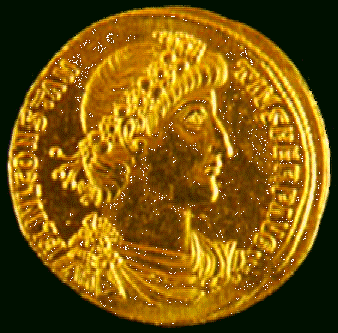|
|
The inauguration of Constantinople. The recognition of Christianity |

Gold coin of Constantine I the Great (reigned 324-337)
The reign of Constantine I, the Great (324-337), that was established after a long period of political turbulence, was marked by two major events that were to transform radically the character of the Roman Empire: the recognition of Christianity and the inauguration of Constantinople.
The former led to the explosive development of Christian monumental art and to the gradual transformation of the Christian church into an official state institution, that evolved in parallel and interlaced with the imperial authority, forming together the two main poles of power in the life of the Empire.
Constantinople was founded at the spot where an ancient Greek colony of the Megara city-state was located, named Byzantion. The ambitious building program of the new imperial residence was planned after the city model of Rome, with Agora, avenues, Hippodrome, churches and public baths. With its inauguration, the Empire's centre of gravity was transferred to the East. There, Greek culture and Hellenistic tradition were predominant, having obtained, however, a particular character in the syncretistic environment of the Near East, during a long period of coexistence with eastern civilizations. Built on a strategic spot and densely fortified by its emperors, it remained intact from deafeat by enemy forces until 1204, when it was seized and sacked by the Latins of the fourth crusade.
The new capital, continually embellished by various rulers and ambitious aristocrats, with luxurious edifices both profane and Christian, became for the next millennium renowned not only for its wealth but also for its artistic primacy over the Medieval European world. It remained the indisputable radiant centre of the Empire's political, economic and cultural life from where all trends sprang and travelled, Byzantium's sphere of influence being far larger than its political boundaries.
© 1998 Oxfordshire Museum Service, Setúbal Museums and the Benaki Museum